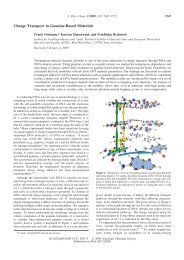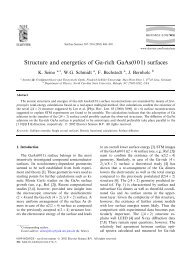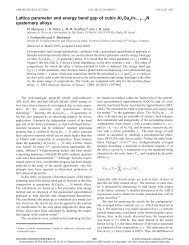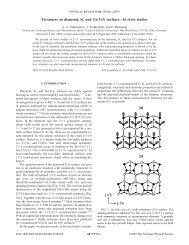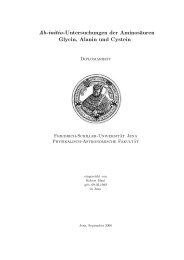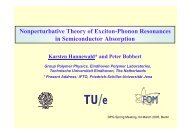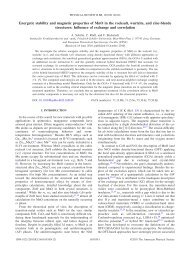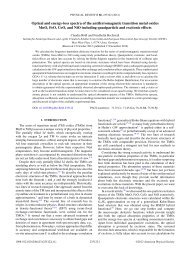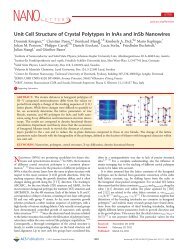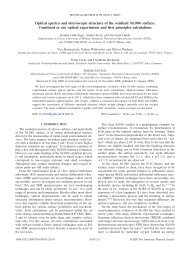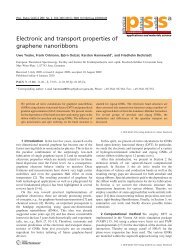Polytypism of GaAs, InP, InAs, and InSb: An ab initio study
Polytypism of GaAs, InP, InAs, and InSb: An ab initio study
Polytypism of GaAs, InP, InAs, and InSb: An ab initio study
Create successful ePaper yourself
Turn your PDF publications into a flip-book with our unique Google optimized e-Paper software.
PHYSICAL REVIEW B 84, 075217 (2011)<br />
<strong>Polytypism</strong> <strong>of</strong> <strong>GaAs</strong>, <strong>InP</strong>, <strong>InAs</strong>, <strong>and</strong> <strong>InSb</strong>: <strong>An</strong> <strong>ab</strong> <strong>initio</strong> <strong>study</strong><br />
Christian Panse, 1,* Dominik Kriegner, 2 <strong>and</strong> Friedhelm Bechstedt 1<br />
1 Institut für Festkörpertheorie und -optik, Friedrich-Schiller-Universität Jena <strong>and</strong> European Theoretical Spectroscopy Facility (ETSF),<br />
Max-Wien-Platz 1, D-07743 Jena, Germany<br />
2 Institute <strong>of</strong> Semiconductor <strong>and</strong> Solid State Physics, Johannes Kepler University Linz, Altenbergerstrasse 69 A-4040 Linz, Austria<br />
(Received 6 April 2011; published 17 August 2011)<br />
A systematic <strong>study</strong> <strong>of</strong> ground state properties <strong>of</strong> cubic (3C) <strong>and</strong> hexagonal (6H ,4H ,2H ) polytypes <strong>of</strong><br />
normal (nonnitride) III-V compounds is reported using well-converged density-functional calculations within<br />
local density approximation, <strong>ab</strong> <strong>initio</strong> pseudopotentials, <strong>and</strong> projector-augmented wave method. Equilibrium<br />
results are obtained for lattice parameters, cohesive energies, <strong>and</strong> bulk moduli. Internal degrees <strong>of</strong> freedom,<br />
i.e., atomic relaxations, are taken into account. Trends with the hexagonality are discussed. Within the axial<br />
next-nearest-neighbor Ising (ANNNI) model driving forces <strong>of</strong> the polytypism as well as the stacking fault<br />
formation are derived. The results are compared with avail<strong>ab</strong>le experimental data.<br />
DOI: 10.1103/PhysRevB.84.075217<br />
PACS number(s): 61.46.Km, 61.66.Fn, 61.50.Ah, 61.50.Ks<br />
I. INTRODUCTION<br />
Highly anisotropic needlelike crystals such as nanowires<br />
<strong>and</strong> whiskers have recently become a strong interest because<br />
<strong>of</strong> their potential as building blocks <strong>of</strong> nanoscale electronic<br />
<strong>and</strong> photonic devices. 1–3 The synthesis <strong>of</strong> such quasi-onedimensional<br />
structures is based on a wide range <strong>of</strong> material<br />
systems. However, III-V semiconductors, e.g., arsenides, phosphides,<br />
<strong>and</strong> antimonides, are <strong>of</strong> particular interest. Because <strong>of</strong><br />
their almost direct character <strong>and</strong> small electron masses they are<br />
especially suit<strong>ab</strong>le for active optoelectronics <strong>and</strong> high-speed<br />
electronics. 1,2<br />
Under ambient conditions the arsenides, phosphides, <strong>and</strong><br />
antimonides <strong>of</strong> Al, Ga, <strong>and</strong> In crystallize in the cubic zincblende<br />
(zb, 3C) geometry. However, studies <strong>of</strong> the atomic<br />
structure <strong>of</strong> III-V nanowires <strong>and</strong> nanorods grown in [111]<br />
direction show significant deviations interpreted first as the<br />
occurrence <strong>of</strong> a large number <strong>of</strong> twin-plane defects. 4,5 Earlier<br />
growth experiments <strong>of</strong> free-st<strong>and</strong>ing <strong>GaAs</strong> wires combined<br />
with transmission electron microscope (TEM) analysis revealed<br />
that the variation <strong>of</strong> the growth temperature could lead<br />
to the formation <strong>of</strong> the hexagonal wurtzite (wz,2H ) structure. 6<br />
This picture has been confirmed in principle later. 7,8 However,<br />
the coexistence <strong>of</strong> wurtzite <strong>and</strong> zinc-blende regions <strong>and</strong> their<br />
intermixing through stacking faults on the (111) planes have<br />
also been pointed out. In addition to the temperature influence,<br />
recent experimental <strong>and</strong> theoretical studies <strong>of</strong> the atomic<br />
morphology <strong>of</strong> III-V nanowire surfaces showed the influence<br />
<strong>of</strong> surface effects on the energetic st<strong>ab</strong>ility <strong>of</strong> wurtzite- <strong>and</strong><br />
zinc-blende-type nanowires. 9,10 Growth kinetics <strong>and</strong> nucleation<br />
also influence the atomic geometry <strong>of</strong> freest<strong>and</strong>ing<br />
nanowires. 11 Besides TEM experiments also phase-sensitive<br />
coherent X-ray diffraction (XRD) with a micr<strong>of</strong>ocused beam 12<br />
demonstrated that the wurtzite contribution is a result <strong>of</strong><br />
stacking faults distributed along the wire. Recent TEM<br />
<strong>and</strong> XRD investigations showed that in whiskers <strong>of</strong> indium<br />
compounds, e.g., <strong>InAs</strong>, <strong>InSb</strong>, 13 <strong>and</strong> <strong>GaAs</strong>, 14,15 the fluctuating<br />
stacking in [111] direction can lead to ordered structures which<br />
were identified as the hexagonal 4H 13–15 <strong>and</strong> even 6H 16<br />
polytype <strong>of</strong> these materials. Even structural pure wurtzite<br />
nanowires as well as polytypic <strong>and</strong> twin-plane superlattices<br />
can be grown. 8,17–20<br />
The discovery <strong>of</strong> 2H <strong>and</strong> 4H polytypes in addition to the 3C<br />
equilibrium structure opens the way to novel physics <strong>and</strong> ideas<br />
for nanowire applications, especially due to the variation <strong>of</strong><br />
the electronic structure with the crystal structure. 21 In the past<br />
several one-dimensional heterostructures have been realized<br />
in semiconductor nanowhiskers 22 or even heterostructures<br />
based on core-shell nanowires. 23 From the basic-physics point<br />
<strong>of</strong> view heterocrystalline but homomaterial junctions are <strong>of</strong><br />
special interest. Such systems have been first predicted 24 <strong>and</strong><br />
realized 25 on the base <strong>of</strong> SiC polytypes. A layer <strong>of</strong> 3C-SiC<br />
with a small energy gap embedded in 4H -SiC with a much<br />
larger fundamental gap may form quantum wells for both<br />
electrons <strong>and</strong> holes. In <strong>InP</strong> <strong>and</strong> <strong>GaAs</strong> nanowires a type-II<br />
b<strong>and</strong> alignment 21,26 has been observed between regions <strong>of</strong> 3C<br />
<strong>and</strong> 2H , which at least may lead to quantum well structures<br />
for one carrier type, the electrons.<br />
Unfortunately, less is known <strong>ab</strong>out the polytypism <strong>of</strong><br />
normal III-V compounds. Only the relationship <strong>of</strong> the 3C<br />
<strong>and</strong> 2H structures has been studied. On the basis <strong>of</strong> <strong>ab</strong><br />
<strong>initio</strong> total-energy calculations it has been concluded that the<br />
wurtzite phase is a metast<strong>ab</strong>le high-pressure modification <strong>of</strong><br />
<strong>InAs</strong> <strong>and</strong> <strong>GaAs</strong> compounds. 26 A theoretical investigation on<br />
growth thermodynamics <strong>of</strong> nanowires by Dubrovskii et al. 27<br />
assigns the lowest formation energy to the 4H polytype. In<br />
the framework <strong>of</strong> a local-density approximation (LDA) <strong>of</strong><br />
the density functional theory (DFT) it has been demonstrated<br />
that in the case <strong>of</strong> zinc-blende compounds with a direct<br />
conduction-b<strong>and</strong> minimum Ɣ 1c , i.e., with the L 1c state <strong>ab</strong>ove<br />
Ɣ 1c , the corresponding wurtzite crystal also has a direct gap<br />
which is however slightly larger. 28 There is a prediction 29 that<br />
3C/2H heterostructures made <strong>of</strong> a direct semiconductor are<br />
<strong>of</strong> type II. Recently the relative st<strong>ab</strong>ility between 2H <strong>and</strong> 3C<br />
structures in III-V nanowires is systematically investigated<br />
based on empirical approaches 30 or DFT-LDA calculations. 10<br />
Also the first quasiparticle b<strong>and</strong> structures have been published<br />
for <strong>InAs</strong> <strong>and</strong> <strong>GaAs</strong> in wurtzite phase. 31 Homojunctions have<br />
been studied theoretically for <strong>InAs</strong> <strong>and</strong> <strong>InP</strong> nanowires. 32–34<br />
In the present paper we <strong>study</strong> the energetic, structural, <strong>and</strong><br />
elastic properties <strong>of</strong> the most important hexagonal polytypes<br />
6H ,4H , <strong>and</strong> 2H in comparison to the well-known unstrained<br />
zinc-blende 3C structure <strong>of</strong> <strong>GaAs</strong>, <strong>InAs</strong>, <strong>InP</strong>, <strong>and</strong> <strong>InSb</strong>. The<br />
cell-internal degrees <strong>of</strong> freedom, i.e., the atomic relaxations,<br />
1098-0121/2011/84(7)/075217(9) 075217-1<br />
©2011 American Physical Society
PANSE, KRIEGNER, AND BECHSTEDT PHYSICAL REVIEW B 84, 075217 (2011)<br />
are taken into account. We derive results for the lattice<br />
constants, atomic positions, cohesive energies, <strong>and</strong> bulk<br />
moduli. The results are discussed versus the hexagonality<br />
<strong>of</strong> the polytype. The polytypism is discussed within the<br />
axial next-nearest-neighbor Ising (ANNNI) model. 35,36 It also<br />
allows the derivation <strong>of</strong> the formation energies <strong>of</strong> two types <strong>of</strong><br />
stacking faults in the zinc-blende polytype.<br />
II. MODELING AND COMPUTATIONAL METHODS<br />
A. Total-energy calculations<br />
The parameter-free total-energy <strong>and</strong> force calculations are<br />
performed in the framework <strong>of</strong> the DFT 37 within the LDA 38<br />
as implemented in the Vienna <strong>ab</strong> <strong>initio</strong> simulation package<br />
(VASP). 39 The exchange-correlation (XC) functional is used<br />
as parametrized by Perdew <strong>and</strong> Zunger. 40 We do not take into<br />
account gradients <strong>of</strong> the electron density within the generalized<br />
gradient approximation (GGA), since LDA gives better<br />
structural parameters for conventional III-V compounds. 41 The<br />
outermost s, p, <strong>and</strong> (in the case <strong>of</strong> Ga <strong>and</strong> In) d electrons<br />
are treated as valence electrons whose interactions with the<br />
remaining ions is modeled by pseudopotentials generated<br />
within the projector-augmented wave (PAW) method. 42 The<br />
electronic wave functions between the cores are exp<strong>and</strong>ed in<br />
a basis set <strong>of</strong> plane waves. Its energy cut<strong>of</strong>f is tested to be<br />
sufficient with 450 eV for the four III-V compounds <strong>GaAs</strong>,<br />
<strong>InP</strong>, <strong>InAs</strong>, <strong>and</strong> <strong>InSb</strong> under consideration. The Brillouin-zone<br />
(BZ) integrations are carried out on Ɣ centered 10 × 10 × M<br />
k-point meshes according to Monkhorst <strong>and</strong> Pack 43 to achieve<br />
an overall energy convergence beneath 1 meV. The value <strong>of</strong> M<br />
has been reduced according to the number <strong>of</strong> layers in stacking<br />
direction <strong>of</strong> the III-V polytype <strong>and</strong> amounts to 10 for zb.<br />
B. Polytype description<br />
Under ambient conditions the four compounds crystallize<br />
in zinc-blende (zb) structure with one free parameter, the cubic<br />
lattice constant a 0 , <strong>and</strong> a primitive unit cell <strong>of</strong> the fcc lattice that<br />
contains two atoms, cation <strong>and</strong> anion, in a distance √ 3a 0 /4<br />
in a cubic [111] direction. The space group is Td<br />
2 (F 43m).<br />
The same structure can be represented in a hexagonal Bravais<br />
lattice with a nonprimitive unit cell containing six atoms,<br />
three cations <strong>and</strong> three anions. In this case the zb crystal is<br />
described by the stacking <strong>of</strong> cation-anion bilayers in [111]<br />
direction called A, B, <strong>and</strong> C. Taking the number <strong>of</strong> bilayers<br />
(p = 3) <strong>and</strong> the cubic character into account the atomic<br />
arrangement can be also called 3C geometry (see Fig. 1). The<br />
corresponding hexagonal lattice constants a <strong>and</strong> c fulfill the<br />
relation 2c/(pa) = √ 8/3 with a = a 0 / √ √<br />
2, c = a 0 3 <strong>and</strong> the<br />
number <strong>of</strong> bilayers per unit cell p. The stacking sequence ABC<br />
can, however, be changed, e.g., to AB, ABCB, or ABCACB, as<br />
indicated in Fig. 1. This leads to hexagonal polytypes pH with<br />
p = 2, 4, or 6 bilayers in [0001] stacking direction to obtain<br />
translation invariance. Thereby, the 2H crystal corresponds<br />
to the well known wurtzite (wz) structure. After introduction<br />
<strong>of</strong> hexagonal Cartesian coordinates x ‖ [110] ‖ [2110],<br />
y ‖ [112] ‖ [0110], <strong>and</strong> z ‖ [111] ‖ [0001] using Miller or<br />
Bravais indices 44 one can define primitive basis vectors <strong>of</strong><br />
FIG. 1. (Color online) Three-dimensional perspective view <strong>of</strong><br />
primitive hexagonal unit cells <strong>of</strong> 3C <strong>and</strong> pH (p = 2, 4, 6) polytypes<br />
<strong>of</strong> binary III-V compounds. The chains <strong>of</strong> bonds in the (11¯20) plane<br />
being characteristic for a certain polytype are represented by thick<br />
solid lines. The stacking sequences are indicated. Red circles (blue<br />
dots) are cations (anions).<br />
the corresponding hexagonal Bravais lattice for pH <strong>and</strong> 3C<br />
polytypes, according to<br />
a 1 = a (1,0,0),<br />
a 2 = a 2 (−1,√ 3,0), (1)<br />
a 3 = c (0,0,1).<br />
The atoms in the hexagonal crystals are still fourfold coordinated.<br />
Only the tetrahedrons could be slightly deformed in<br />
c-axis direction as well known for SiC polytypes. 45<br />
The resulting atomic geometries are depicted in Fig. 1. In<br />
the hexagonal polytypes the atoms <strong>of</strong> the p cation-anion pairs<br />
are all on trigonal axes in positions in agreement with the<br />
C6v 4 (P 6 3mc) space-group symmetry. The general formation<br />
laws are given in the textbook <strong>of</strong> Wyckh<strong>of</strong>f 46 or can be taken<br />
from the characteristic chain structures within the unit cells in<br />
Fig. 1. Using the three basis vectors a i (i = 1, 2, 3) in (1) <strong>and</strong><br />
displacing them eventually by a 1 or a 2 toward the coordinate<br />
zero the 2p atoms are in the following positions. For the 2H<br />
wurtzite structure one has<br />
( )<br />
1<br />
(0,0,u),<br />
2 ,2 3 ,1 2 + u (2)<br />
with u(cation) = 0 <strong>and</strong> u(anion) = 3 + ε with a small dimensionless<br />
cell-internal structural parameter ε describing<br />
8<br />
deviations<br />
√<br />
from ideal tetrahedrons together with 2c/(pa) ≠<br />
8/3. In the 4H ,6H , <strong>and</strong> 3C cases the formation laws are<br />
(0,0,u),<br />
( 1<br />
2 ,2 3 ,v )<br />
,<br />
( 2<br />
3 ,1 3 ,w )<br />
. (3)<br />
For 4H it holds u(cation) = 0, u(anion) = 3<br />
16 + ε(1),<br />
v(cation) = 1 4 + δ(2) <strong>and</strong> 3 4 + δ(2), v(anion) = 7 + ε(2) <strong>and</strong><br />
16<br />
15<br />
16 + ε(2). w(cation) = 1 11<br />
, w(anion) = + ε(1). For 6H one<br />
2 16<br />
has u(cation) = 0 <strong>and</strong> 1 2 , u(anion) = 1 8 + ε(1) <strong>and</strong> 5 8 + ε(1),<br />
v(cation) = 1 6 + δ(2) <strong>and</strong> 5 6 + δ(3), v(anion) = 7 + ε(2) <strong>and</strong><br />
24<br />
22<br />
24 + ε(3), w(cation) = 1 3 + δ(3) <strong>and</strong> 2 + δ(2), w(anion) =<br />
3<br />
075217-2
POLYTYPISM OF <strong>GaAs</strong>, <strong>InP</strong>, <strong>InAs</strong>, AND <strong>InSb</strong>: AN ... PHYSICAL REVIEW B 84, 075217 (2011)<br />
FIG. 2. (Color online) Isoenergy lines (in a distance <strong>of</strong> 1 meV) <strong>of</strong> the total energy E(c,a) per cation-anion pair <strong>of</strong> pH (p = 2, 4, 6)<br />
polytypes <strong>of</strong> <strong>InSb</strong> without taking cell-internal relaxations into account. Their center allows to read the equilibrium values E, c, <strong>and</strong>a. The<br />
optimized 2c/(pa) line is given in red. For the purpose <strong>of</strong> comparison the ideal ratio is also depicted in blue.<br />
11<br />
19<br />
+ ε(3) <strong>and</strong> + ε(2). In the 3C case all positions are fixed<br />
24 24<br />
at u(cation) = 0, u(anion) = 1 4 , v(cation) = 1 3 , v(anion) = 7<br />
12 ,<br />
w(cation) = 2 11<br />
, w(anion) = . The small parameters ε(i) <strong>and</strong><br />
3 12<br />
δ(i) characterize the additional degrees <strong>of</strong> freedom, one for<br />
2H , three for 4H , <strong>and</strong> five for 6H , which have to be optimized<br />
in order to obtain the ground state structure.<br />
Figure 1 suggests the inequivalence <strong>of</strong> the three bilayers<br />
A, B, <strong>and</strong> C whose special arrangement leads to one <strong>of</strong> the<br />
polytypes. In addition, comparing 3C with the hexagonal<br />
polytypes the cubic (c) or hexagonal (h) character <strong>of</strong> the<br />
cation-anion double layers can be defined according to<br />
the parallel or nonparallel limiting bonds. In hexagonal layers<br />
the bonds <strong>and</strong> hence the tetrahedra are rotated by 180 ◦ around<br />
the c-axis. In other words, in a hexagonal layer the two adjacent<br />
bilayers are equivalent in contrast to a cubic layer, where<br />
the two adjacent bilayers differ. The ratio <strong>of</strong> the hexagonal<br />
layers <strong>and</strong> the total number <strong>of</strong> bilayers per unit cell gives the<br />
percentage hexagonality <strong>of</strong> the polytype, 0% (3C), 33% (6H ),<br />
50% (4H ), <strong>and</strong> 100% (2H ). The denotation <strong>of</strong> the bilayers by<br />
h <strong>and</strong> c leads to the earlier used polytype notation (h) 2 for 2H ,<br />
(hc) 2 for 4H , <strong>and</strong> (hcc) 2 for 6H <strong>of</strong> Jagodzinski. 47<br />
C. Atomic positions<br />
In order to determine the equilibrium geometries we minimize<br />
the total energy E with respect to the atomic coordinates.<br />
In the zinc-blende case this is easy since only the equilibrium<br />
lattice constant a 0 has to be computed with an accuracy <strong>of</strong> the<br />
total energy per cation-anion pair below 1 meV. Total energy<br />
calculations for various values <strong>of</strong> a 0 gave the equilibrium<br />
geometry through a fitting to the Murnaghan’s equation <strong>of</strong><br />
state. This leads to bulk lattice constants a 0 = 5.611 Å (<strong>GaAs</strong>),<br />
5.830 Å (<strong>InP</strong>), 6.032 Å (<strong>InAs</strong>), <strong>and</strong> 6.454 Å (<strong>InSb</strong>) as well<br />
as to cohesive energies per pair (without spin-polarization<br />
corrections for the free atoms) <strong>of</strong> E coh = 9.607 eV (<strong>GaAs</strong>),<br />
9.643 eV (<strong>InP</strong>), 9.002 eV (<strong>InAs</strong>), <strong>and</strong> 8.189 eV (<strong>InSb</strong>).<br />
The typical overbinding effect <strong>of</strong> the LDA is obvious. The<br />
calculated lattice constants are smaller by 0.8% (<strong>GaAs</strong>),<br />
0.7% (<strong>InP</strong>), 0.4% (<strong>InAs</strong>), <strong>and</strong> 0.4% (<strong>InSb</strong>) in comparison to<br />
experimental (room-temperature) values. 48 This fact has to be<br />
taken in mind when predicting equilibrium lattice parameters<br />
for the hexagonal polytypes.<br />
In the case <strong>of</strong> the hexagonal polytypes we apply a three-step<br />
procedure. For vanishing parameters ε(i) <strong>and</strong> δ(i) the total<br />
energy E = E(c,a) is determined on a regular (c,a) grid.<br />
Then the cell-internal geometry against the total energy is<br />
optimized. In the last step E(c,a) is minimized, but now<br />
under the constraint <strong>of</strong> the obtained cell-internal parameters.<br />
Within the last step we resolve the interplay <strong>of</strong> unit cell shape<br />
(c,a) <strong>and</strong> the cell-internal relaxation, at least in a first-order<br />
manner. Compared to a simultaneous optimization <strong>of</strong> all<br />
lattice parameters our method is sufficient, as shown later in<br />
Fig. 4. The resulting energy surface is illustrated in Fig. 2 for<br />
the example <strong>of</strong> <strong>InSb</strong>. Our experience with the cell-internal<br />
optimization is that the parameters ε(i) (i = 1, 2, 3) <strong>and</strong><br />
δ(i) (i = 2, 3) for 6H are so small that an influence by the<br />
numerical accuracy cannot be excluded in agreement with<br />
the low hexagonality. For that reason we decided to set these<br />
parameters to zero <strong>and</strong> only present the results for 2H (ε) <strong>and</strong><br />
4H [ε(1), δ(2), <strong>and</strong> ε(2)]. This is somewhat different to silicon<br />
carbide polytypes 49 where also the small relative cell-internal<br />
displacements play a role for 6H .<br />
The resulting (equilibrium) lattice constants c <strong>and</strong> a define<br />
the (equilibrium) volume per III-V pair V pair = √ 3<br />
2 a2 c p .This<br />
formula allows us to define a volume dependence <strong>of</strong> the<br />
total energy E = E(V ). From the E(c,a) data sets we obtain<br />
the bulk moduli <strong>of</strong> the hexagonal polytypes following the<br />
procedure proposed in Ref. 50. A fit to Murnaghan’s equation<br />
<strong>of</strong> state 51 then yields the isothermal bulk modulus B 0 .<br />
III. EQUILIBRIUM GEOMETRY AND STABILITY<br />
A. General trends<br />
The results <strong>of</strong> the minimization <strong>of</strong> the total energy as well<br />
as the fit procedure to Murnaghan’s equation <strong>of</strong> state are<br />
listed in T<strong>ab</strong>le I. Here the cell-internal parameters <strong>of</strong> 2H ,<br />
4H , <strong>and</strong> 6H have been fixed at the ideal values. Clear trends<br />
075217-3
PANSE, KRIEGNER, AND BECHSTEDT PHYSICAL REVIEW B 84, 075217 (2011)<br />
TABLE I. Structural (c, a, V pair ), energetic (E with respect to the 3C value), <strong>and</strong> average elastic properties (B 0 ) <strong>of</strong> III-V polytypes. The<br />
3C lattice constants are given referring to the corresponding hexagonal unit cell, i.e., a = a 0 / √ 2<strong>and</strong>c = a 0<br />
√<br />
3.<br />
Compound Polytype 2c/p a 2c/(pa) V pair E B 0<br />
(Å) (Å) (Å 3 ) (meV) (GPa)<br />
<strong>GaAs</strong> 2H 6.5095 3.9556 1.6456 44.103 23.1 74.7<br />
4H 6.4919 3.9606 1.6396 44.096 10.4 74.4<br />
6H 6.4881 3.9626 1.6374 44.114 6.3 74.4<br />
3C 6.4790 3.9676 1.6330 44.164 0.0 73.9<br />
<strong>InP</strong> 2H 6.7515 4.1148 1.6408 49.499 10.6 71.2<br />
4H 6.7409 4.1182 1.6369 49.503 4.5 71.1<br />
6H 6.7379 4.1194 1.6356 49.510 2.5 69.2<br />
3C 6.7319 4.1224 1.6330 49.539 0.0 71.0<br />
<strong>InAs</strong> 2H 6.9894 4.2570 1.6419 54.846 19.1 61.9<br />
4H 6.9764 4.2605 1.6375 54.834 8.1 59.9<br />
6H 6.9727 4.2620 1.6360 54.844 5.0 58.5<br />
3C 6.9653 4.2653 1.6330 54.869 0.0 60.3<br />
<strong>InSb</strong> 2H 7.4806 4.5547 1.6424 67.198 20.7 46.9<br />
4H 7.4654 4.5586 1.6377 67.176 9.6 46.9<br />
6H 7.4613 4.5606 1.6360 67.198 5.8 47.0<br />
3C 7.4527 4.5638 1.6330 67.281 0.0 46.8<br />
are observed along the row 2H ,4H ,6H , <strong>and</strong> 3C. The lattice<br />
constant in c-axis direction normalized to two cation-anion<br />
bilayers as in 2H ,2c/p, increases while the lateral lattice<br />
constant a decreases along the row 3C→2H . This happens<br />
for all considered III-V compounds. In contrast, the volume<br />
per cation-anion pair V pair only shows a very weak dependence<br />
on the polytype. The volume is almost conserved. The weak<br />
dependence on the hexagonality is monotonous only for <strong>InP</strong>.<br />
For the other compounds the volume exhibits a minimum<br />
for 4H , i.e., for 50% hexagonality. As a consequence <strong>of</strong> the<br />
almost volume conservation the effective lattice constant ratio<br />
2c/(pa) increases from its ideal value √ 8/3 = 1.6330 in 3C<br />
to 2H . This behavior is in accordance with the empirical rule<br />
<strong>of</strong> Lawaetz, 52 which states that compounds with zinc-blende<br />
ground state should have c/a ratios larger than the ideal value<br />
for their (unst<strong>ab</strong>le) wurtzite phase. This rule is supported<br />
by first-principles calculations on III-V compounds 53 <strong>and</strong><br />
predictions <strong>of</strong> the ANNNI model. 54 The increase <strong>of</strong> 2c/(pa)<br />
is almost linear in the polytype hexagonality as demonstrated<br />
in Fig. 3(a). The structural trends along the polytypes are in<br />
qualitative agreement with those for the prototypical material<br />
SiC. 45<br />
Along the variation <strong>of</strong> the anion X = P,As,Sbinthe<br />
InX compounds, one observes a clear chemical trend. For<br />
the deformation <strong>of</strong> the bonding tetrahedra c/(pa) is a clear<br />
measure. It is the largest for the InX compound with the<br />
largest bond length <strong>InSb</strong>. The trend with the size <strong>of</strong> the anion<br />
<strong>and</strong> therefore with the average bond length is clearly visible.<br />
A smaller anion covalent radius will reduce the deformation,<br />
hence decrease c/(pa), smaller cations (In→Ga) will increase<br />
it. Comparing only zinc-blende <strong>and</strong> wurtzite structures similar<br />
findings have been made by Yeh et al. 55<br />
FIG. 3. (Color online) Structural <strong>and</strong> energetic properties as function <strong>of</strong> the hexagonality <strong>of</strong> the polytype. (a) Renormalized lattice constant<br />
ratio 2c/(pa). (b) Cohesive energy per cation-anion pair relative to the 3C value. Lines are only given to guide the eye.<br />
075217-4
POLYTYPISM OF <strong>GaAs</strong>, <strong>InP</strong>, <strong>InAs</strong>, AND <strong>InSb</strong>: AN ... PHYSICAL REVIEW B 84, 075217 (2011)<br />
The st<strong>ab</strong>ility <strong>of</strong> the polytypes also follows a monotonous<br />
decrease along the row 3C, 6H ,4H , <strong>and</strong> 2H (see T<strong>ab</strong>le I).<br />
The variation <strong>of</strong> the relative total energy per pair is however<br />
nonlinear as shown in Fig. 3(b). Among the considered<br />
semiconductors the one with the lowest tendency to crystallize<br />
in hexagonal polytypes is <strong>GaAs</strong>. The energy difference per<br />
pair between wz <strong>and</strong> zb amounts to 23.1 meV <strong>and</strong> is almost<br />
identical with previously published values <strong>of</strong> 25.0 28 <strong>and</strong><br />
23.4 meV. 29 Among the InX compounds a chemical trend<br />
is visible. However, whereas the energy deviations from the<br />
3C value are more or less identical for <strong>InAs</strong> <strong>and</strong> <strong>InSb</strong> with<br />
the bigger anions, the energy differences for <strong>InP</strong> (see T<strong>ab</strong>le I)<br />
are the smallest ones. That means that in thermal equilibrium<br />
stacking fluctuations with respect to the ABC stacking <strong>of</strong> the<br />
zinc-blende geometry should be easier possible for <strong>InP</strong> in<br />
comparison with other III-V compounds. One reason may be<br />
that among the covalent radii <strong>of</strong> 1.26 (Ga), 1.44 (In), 1.06 (P),<br />
1.20 (As), <strong>and</strong> 1.40 Å (Sb) 56 the cation-anion radii difference<br />
<strong>of</strong> <strong>InP</strong> is the biggest. To discuss chemical trends in a more<br />
sophisticated way we compare the compounds via their charge<br />
asymmetry coefficient (i.e., their ionicity) 0.294 (<strong>InSb</strong>), 0.316<br />
(<strong>GaAs</strong>), 0.450 (<strong>InAs</strong>), <strong>and</strong> 0.506 (<strong>InP</strong>). 57 The largest value<br />
for <strong>InP</strong> indicates its stronger ionic character which yields the<br />
higher st<strong>ab</strong>ility <strong>of</strong> the hexagonal phases among the considered<br />
compounds.<br />
The bulk modulus B 0 only weakly varies with the polytype.<br />
The weak variations do also not show clear trends with the<br />
hexagonality, similar to the case <strong>of</strong> SiC polytypes. 45 The<br />
deviations to the experimental zinc-blende values are smaller<br />
than 2%. 58<br />
B. Influence <strong>of</strong> atomic relaxations<br />
The relaxation <strong>of</strong> the atomic positions within the unit cells<br />
<strong>of</strong> the hexagonal crystals 2H <strong>and</strong> 4H , i.e., the deviations <strong>of</strong><br />
the parameters ε (2H ) <strong>and</strong> ε(1), δ(2), ε(2) (4H ) are listed in<br />
T<strong>ab</strong>le II. They are small but <strong>of</strong> the same order <strong>of</strong> magnitude as<br />
in the case <strong>of</strong> the SiC <strong>and</strong> group-IV polytypes. 45,49,59 The most<br />
important differences are the signs <strong>of</strong> ε (2H ) <strong>and</strong> δ(2) (4H ).<br />
In contrast to SiC, in the III-V compounds there is a tendency<br />
for a small increase <strong>of</strong> the cation-anion bond lengths parallel<br />
to the c-axis relative to the bonds forming angles <strong>of</strong> <strong>ab</strong>out 70 ◦<br />
with the c-axis (see Fig. 1). Our findings are not in agreement<br />
with the conservation <strong>of</strong> the bond length in the average. Such<br />
a conservation law leads to the relation ε = 1 8 [ 8 3 ( a c )2 − 1] in<br />
the 2H case. 45 Considering a <strong>and</strong> c from T<strong>ab</strong>le I one obtains<br />
the values ε =−22.4 (<strong>GaAs</strong>), −14.1 (<strong>InP</strong>), −16.1 (<strong>InAs</strong>),<br />
−18.0 × 10 −4 (<strong>InSb</strong>). These displacements have the correct<br />
sign but their <strong>ab</strong>solute values are by a factor <strong>of</strong> 3 larger than<br />
the optimized ones in T<strong>ab</strong>le II.<br />
TABLE II. Cell-internal parameters ε (2H )<strong>and</strong>ε(1), δ(2), ε(2)<br />
(4H ). For def<strong>initio</strong>n see text.<br />
ε × 10 4 ε(1) × 10 4 δ(2) × 10 4 ε(2) × 10 4<br />
<strong>GaAs</strong> −8.5 4.4 5.3 −3.5<br />
<strong>InP</strong> −4.2 2.5 1.6 −3.0<br />
<strong>InAs</strong> −5.3 3.0 2.5 −3.5<br />
<strong>InSb</strong> −6.2 3.9 3.9 −3.0<br />
The additional degrees <strong>of</strong> freedom in the atomic positions<br />
<strong>and</strong> hence the higher flexibility <strong>of</strong> the bonds lead to larger<br />
relative changes a/a <strong>and</strong> c/c <strong>of</strong> the lattice constants with<br />
respect to the zinc-blende values (see T<strong>ab</strong>le III). However,<br />
these changes remain small. The <strong>ab</strong>solute values for all<br />
compounds are below 0.5%. As a consequence <strong>of</strong> the different<br />
signs the largest changes happen for the effective c/a ratio,<br />
more precisely 2c/(pa). The additional relaxation <strong>of</strong> the<br />
atomic positions further amplifies this increase <strong>of</strong> the aspect<br />
ratio for the hexagonal polytypes.<br />
Additionally the cell-internal relaxation has significant<br />
impact on the bond length along the c-axis inside the cubic<br />
(d cub ) <strong>and</strong> hexagonal (d hex ) bilayers. While cubic bilayers<br />
are compressed along the c-direction, the hexagonal ones<br />
are stretched. This selective (inhomogeneous) deformation<br />
leads to a relative change in the characteristic bond lengths<br />
along the c-axis <strong>of</strong> <strong>ab</strong>out d cub =−0.15% for the cubic <strong>and</strong><br />
d hex =+0.42% for the hexagonal bilayers <strong>of</strong> the 4H -<strong>InSb</strong><br />
polytype. The different signs <strong>of</strong> the relative variations can<br />
easily be explained by the different stacking sequences <strong>of</strong> a<br />
hexagonal (ABA) <strong>and</strong> cubic (ABC) layer. In the hexagonal<br />
case the neighboring layers are on top <strong>of</strong> each other which<br />
yields a third next neighbor repulsive force as described by<br />
Ito et al. 60 In contrast to that the adjacent bilayers <strong>of</strong> a cubic<br />
layer are twisted by 60 ◦ which facilitates a compression. With<br />
the calculated signs <strong>of</strong> the internal parameters (T<strong>ab</strong>le II) the<br />
following relation is valid for the 4H phase <strong>of</strong> the calculated<br />
III-V polytypes:<br />
d hex − d cub = [ε(1) − ε(2) + δ(2)] c<br />
= [|ε(1)|+|ε(2)|+|δ(2)|] c. (4)<br />
In other words, the directions <strong>of</strong> the displacements through<br />
the cell-internal relaxation, i.e., the signs <strong>of</strong> the internal<br />
parameters, increase d hex − d cub . Therefore, the role <strong>of</strong> the<br />
cell-internal parameters for the ground state geometry lies<br />
within some kind <strong>of</strong> partial compensation <strong>of</strong> the inequality<br />
<strong>of</strong> cubic <strong>and</strong> hexagonal bilayers. This bond-length difference<br />
between cubic <strong>and</strong> hexagonal stackings explains the linear<br />
scaling with hexagonality for the different properties. We point<br />
out that, even if the internal relaxation is neglected, the cell<br />
shape will change in a way that an average bilayer stretching<br />
is realized. In the case <strong>of</strong> 4H -<strong>InSb</strong> both characteristic bond<br />
lengths are stretched by <strong>ab</strong>out +0.17% with respect to the<br />
value in 3C.<br />
Our results on the cell-internal relaxation differ significantly<br />
from former first-principles calculations by Wang<br />
et al., 61 which reach compar<strong>ab</strong>le accuracy concerning internal<br />
parameters. Wang et al. report c/a ratios beneath 1.6330 for<br />
<strong>InAs</strong> <strong>and</strong> <strong>InSb</strong> with nonnegative ɛ <strong>of</strong> <strong>ab</strong>out +5 × 10 −4 (<strong>InAs</strong>)<br />
<strong>and</strong> 0 (<strong>InSb</strong>). These findings are in contrast to the empirical<br />
rule <strong>of</strong> Lawaetz 52 confirmed by Yeh et al. 53 <strong>and</strong> our work, after<br />
which compounds with zb ground state should have c/a ratios<br />
<strong>ab</strong>ove the ideal 1.6330 in their wz phase. Also these findings<br />
do not agree with the most recent XRD measurements. 20<br />
The differences may come from an inappropriate treatment<br />
<strong>of</strong> the cell-internal relaxation <strong>and</strong> the analytically described<br />
pseudopotentials where the shallow d electrons are frozen into<br />
the core.<br />
075217-5
PANSE, KRIEGNER, AND BECHSTEDT PHYSICAL REVIEW B 84, 075217 (2011)<br />
TABLE III. Relative deviations <strong>of</strong> lattice constants from those <strong>of</strong><br />
most st<strong>ab</strong>le 3C polytype (in percent). The deviations without (w/o)<br />
<strong>and</strong> with (w) inclusion <strong>of</strong> the finite cell-internal parameters from<br />
T<strong>ab</strong>le II are given separately.<br />
a/a c/c 2c<br />
pa / 2c<br />
pa<br />
w/o w w/o w w/o w<br />
<strong>GaAs</strong> 2H −0.30 −0.35 0.48 0.55 0.77 0.91<br />
4H −0.17 −0.19 0.24 0.28 0.40 0.47<br />
6H −0.13 – 0.14 – 0.26 –<br />
<strong>InP</strong> 2H −0.18 −0.21 0.30 0.36 0.48 0.57<br />
4H −0.10 −0.11 0.14 0.17 0.24 0.28<br />
6H −0.07 – 0.09 – 0.16 –<br />
<strong>InAs</strong> 2H −0.20 −0.23 0.35 0.42 0.55 0.65<br />
4H −0.11 −0.13 0.16 0.20 0.27 0.33<br />
6H −0.08 – 0.11 – 0.18 –<br />
<strong>InSb</strong> 2H −0.20 −0.25 0.38 0.47 0.58 0.73<br />
4H −0.11 −0.13 0.17 0.22 0.28 0.35<br />
6H −0.07 – 0.12 – 0.18 –<br />
C. Comparison with experiment<br />
Experimental data <strong>of</strong> the structural properties for hexagonal<br />
polytypes <strong>of</strong> bulk III-V compounds are generally not avail<strong>ab</strong>le.<br />
However, very recently lattice constants <strong>of</strong> the 2H <strong>and</strong> 4H<br />
phases <strong>of</strong> <strong>InAs</strong> <strong>and</strong> <strong>InSb</strong> 20 have been obtained from XRD in<br />
grazing incidence.<br />
Asymmetric reciprocal space maps have been recorded in<br />
order to obtain the lattice parameters <strong>of</strong> the 3C, 2H , <strong>and</strong> 4H<br />
polytypes independently. The nanowires were grown using<br />
chemical beam epitaxy (<strong>InAs</strong>) <strong>and</strong> metal-organic vapor phase<br />
epitaxy (<strong>InAs</strong> <strong>and</strong> <strong>InSb</strong>). The cubic reference values used in<br />
this <strong>study</strong> were a 0 = 6.058 Å (<strong>InAs</strong>) <strong>and</strong> a 0 = 6.478 Å (<strong>InSb</strong>)<br />
taken from Ref. 62.<br />
The experimental studies 20 yielded the relative changes<br />
a/a =−0.23%, c/c = 0.42% for 2H -<strong>InAs</strong>, a/a =<br />
−0.23%, c/c = 0.54% for 2H -<strong>InSb</strong>, a/a =−0.14%,<br />
c/c = 0.19% for 4H -<strong>InAs</strong>, <strong>and</strong> a/a =−0.14%,c/c=<br />
0.28% for 4H -<strong>InSb</strong>. The signs <strong>and</strong> the <strong>ab</strong>solute values<br />
are in excellent agreement with the computed deviations in<br />
T<strong>ab</strong>le III. This holds especially after inclusion <strong>of</strong> the atomic<br />
relaxation, which improves the agreement. Only for c/c <strong>of</strong><br />
<strong>InSb</strong> the calculated results seem to slightly underestimate<br />
the measured ones. However, taking the inaccuracies <strong>of</strong><br />
the computational approaches <strong>and</strong> uncertainties due to the<br />
nanowire measurements into account, we can state a excellent<br />
prediction <strong>of</strong> the atomic geometries <strong>of</strong> the hexagonal III-V<br />
polytypes by the DFT studies. Only the <strong>ab</strong>solute distances have<br />
to be rescaled by the small deviations (
POLYTYPISM OF <strong>GaAs</strong>, <strong>InP</strong>, <strong>InAs</strong>, AND <strong>InSb</strong>: AN ... PHYSICAL REVIEW B 84, 075217 (2011)<br />
FIG. 4. (Color online) Influence <strong>of</strong> atomic relaxation on the relative lattice constant deviations from their ideal (i.e., 3C) values for <strong>InAs</strong><br />
<strong>and</strong> <strong>InSb</strong>. Constant effective 2c/(pa) ratios are indicated by blue dotted lines, while black dotted lines represent constant volumes V pair per<br />
cation-anion pair for the 3C value <strong>and</strong> small deviations. Theoretical results (a) without <strong>and</strong> (b) with internal relaxation are connected by arrows.<br />
For comparison also the result (c) for one full optimization, i.e., a, c,<strong>and</strong>ε are optimized independently, is shown for 2H -<strong>InAs</strong>. Experimental<br />
data (c/c, a/a) 20 are given by squares.<br />
<strong>and</strong> J 1 /J 2 as vari<strong>ab</strong>les. In the interesting parameter region one<br />
multiphase degeneracy appears. For J 3 = 0 <strong>and</strong> J 1 =−2J 2<br />
the phases <strong>of</strong> low hexagonality 3C, 6H , <strong>and</strong> 4H degenerate.<br />
The III-V compounds are far away from the phase boundary<br />
between 3C <strong>and</strong> 6H . Nevertheless, there are differences. While<br />
3C-<strong>InSb</strong> is clearly most st<strong>ab</strong>le, the 3C polytype <strong>of</strong> <strong>InAs</strong> <strong>and</strong><br />
<strong>InP</strong> are much closer to the phase boundary. Therefore, these<br />
compounds should show the strongest stacking fluctuations in<br />
the nanorods under equilibrium conditions. The comparison<br />
with the energy differences in T<strong>ab</strong>le I makes obvious that the<br />
energy differences between wurtzite <strong>and</strong> zinc-blende phases<br />
not only solely determine such a tendency. The phase diagram<br />
directly reflects the chemical trend with respect to the charge<br />
asymmetry coefficient g given in T<strong>ab</strong>le IV. As the ionicity<br />
(respectively, the charge asymmetry coefficient g <strong>and</strong> the<br />
covalent radii difference) increases the distance to the 3C-6H<br />
phase boundary decreases. In a simple picture one can explain<br />
this fact with an increasing intrinsic inhomogenity due to the<br />
bigger difference <strong>of</strong> the covalent radii, which makes easier the<br />
incorporation <strong>of</strong> stacking faults or twist <strong>of</strong> atomic layers.<br />
C. Stacking faults<br />
Further information can be extracted from the ANNNI<br />
model. Most important is the energetics <strong>of</strong> the formation<br />
<strong>of</strong> stacking faults in the zinc-blende polytype. 64 Since the<br />
normal stacking in the zinc-blende polytype is ABCABC... the<br />
intrinsic stacking fault (ISF) represents a removed bilayer from<br />
the infinite stacking sequence. It may result in a ABCA/CAB...<br />
stacking if a B layer is taken away. A possible formation<br />
process could be related to condensation <strong>of</strong> vacancies. <strong>An</strong>other<br />
process generating an ISF is a plastic glide caused by<br />
TABLE IV. Interaction parameters J i (in meV per cation-anion<br />
pair) <strong>of</strong> the ANNNI model (5). For comparison SiC values 64 are<br />
also given. To illustrate the chemical trend the charge asymmetry<br />
coefficients 57,65 g as a measure <strong>of</strong> the ionicity are given.<br />
g J 1 J 2 J 3 J 3 /J 2 J 1 /J 2<br />
<strong>InSb</strong> 0.294 10.80 −0.38 −0.45 1.200 −28.8<br />
<strong>GaAs</strong> 0.316 12.03 −0.58 −0.48 0.828 −20.9<br />
<strong>InAs</strong> 0.450 9.85 −0.73 −0.30 0.414 −13.6<br />
<strong>InP</strong> 0.506 5.68 −0.40 −0.38 0.938 −14.2<br />
SiC 0.476 1.18 −2.34 −0.32 0.137 −0.5<br />
FIG. 5. (Color online) Phase diagram for the polytypes within<br />
the ANNNI model. The 3C equilibrium structures are indicated by<br />
black dot (<strong>GaAs</strong>), blue square (<strong>InP</strong>), red triangle (<strong>InAs</strong>), <strong>and</strong> green<br />
diamond (<strong>InSb</strong>). For comparison the 4H equilibrium structure <strong>of</strong> SiC<br />
is indicated by an open circle.<br />
075217-7
PANSE, KRIEGNER, AND BECHSTEDT PHYSICAL REVIEW B 84, 075217 (2011)<br />
TABLE V. Stacking fault formation energies E (meV/atom) <strong>and</strong><br />
γ (mJ/m 2 )forthe3C structure. The experimental values are taken<br />
from Refs. 67 <strong>and</strong> 68.<br />
ESF<br />
ISF<br />
E γ E γ<br />
Calc. Calc. Calc. Expt. Calc. Expt.<br />
<strong>GaAs</strong> 39.7 46.7 43.9 47 ± 5 51.6 55 ± 5<br />
<strong>InP</strong> 16.5 18.0 19.6 17 ± 3 21.3 18 ± 3<br />
<strong>InAs</strong> 31.2 31.7 35.3 30 ± 3 35.9 30 ± 3<br />
<strong>InSb</strong> 36.6 32.5 39.9 43 ± 4 35.4 38 ± 4<br />
shear stress applied to the 3C crystal. One speaks <strong>ab</strong>out an<br />
extrinsic stacking fault (ESF) after adding a double layer to<br />
the stacking sequence, for example, due to condensation <strong>of</strong><br />
eigeninterstitials. Adding a C bilayer the resulting stacking<br />
sequence is ABCA/C/BCABC.... The occurrence <strong>of</strong> such<br />
stacking faults can also be discussed in terms <strong>of</strong> a twist by<br />
180 ◦ <strong>of</strong> the three equivalent bonds between two bilayers in<br />
a bonding tetrahedron nonparallel to the [111] axis. Then,<br />
besides staggered (cubic) layers also eclipsed (hexagonal)<br />
bilayers appear. 64<br />
Within the ANNNI model (4) the formation energies <strong>of</strong><br />
such a stacking fault E(ISF/ESF) with respect to the infinite<br />
stacking <strong>of</strong> the 3C polytype can easily be derived. Per atom<br />
in a two-dimensional cell perpendicular to the [111] axis one<br />
finds<br />
E ISF = 4J 1 + 4J 2 + 4J 3 ,<br />
E ESF = 4J 1 + 8J 2 + 8J 3 .<br />
With the sign <strong>of</strong> the interaction parameters in T<strong>ab</strong>le IV<br />
it becomes obvious that the extrinsic stacking faults are<br />
energetically favor<strong>ab</strong>le versus the intrinsic stacking faults in<br />
agreement with experimental values, as known for silicon<br />
crystals. 66 The stacking-fault formation energies γ (ISF/ESF)<br />
per unit area follow from E(ISF/ESF) by division with the<br />
area √ 3a0 2 /4 <strong>of</strong> one atom in a (111) plane.<br />
The calculated energy results are listed in T<strong>ab</strong>le V <strong>and</strong><br />
compared with measured values. 67,68 The interesting point<br />
is that the stacking fault formation energies are not directly<br />
related to the bonding energy or the cohesive energy <strong>of</strong><br />
the compound. Within the In compounds there is a clear<br />
correlation with the bond length or the lattice constant.<br />
However, the direct proportionality is in contrast to the scaling<br />
with the inverse lattice constant found for the stacking fault<br />
formation energies <strong>of</strong> covalent group-IV semiconductors. 64,69<br />
(7)<br />
Experimentally it is rather difficult to distinguish between<br />
extrinsic <strong>and</strong> intrinsic stacking faults. In the literature 67,68 only<br />
formation energies <strong>of</strong> stacking faults are given. However, the<br />
measured values given in T<strong>ab</strong>le V are in excellent agreement<br />
within the error bars with the formation energies <strong>of</strong> intrinsic<br />
stacking faults computed within the ANNNI model (see<br />
interaction parameters in T<strong>ab</strong>le IV). The <strong>ab</strong>solute values <strong>of</strong><br />
the formation energies for especially extrinsic stacking faults<br />
E(ESF) <strong>of</strong> the order <strong>of</strong> the thermal energy k B T at room<br />
temperature indicate that even in bulk zinc-blende crystals <strong>of</strong><br />
III-V compounds stacking faults are likely. In nanorods grown<br />
in [111] direction stacking fluctuations <strong>and</strong> therefore the local<br />
formation <strong>of</strong> hexagonal polytypes pH are prob<strong>ab</strong>le.<br />
V. SUMMARY AND CONCLUSIONS<br />
In summary, we have performed first-principles calculations<br />
for the structural, energetic, <strong>and</strong> elastic properties <strong>of</strong><br />
hexagonal polytypes 2H , 4H , <strong>and</strong> 6H <strong>of</strong> common III-V<br />
semiconductors which crystallize in zinc-blende 3C geometry<br />
under ambient conditions. We have observed clear tendencies<br />
for the enlargement <strong>of</strong> the average cation-anion bilayer<br />
thickness c/p in [0001] direction but a decrease <strong>of</strong> the lateral<br />
(in-plane) lattice constant a with respect to their ideal values<br />
derived from the 3C crystal. On the one h<strong>and</strong>, the volume<br />
per cation-anion pair is almost conserved. On the other h<strong>and</strong>,<br />
the effective ratio 2c/(pa) increases with the hexagonality <strong>of</strong><br />
the polytype. The agreement with measured lattice-constant<br />
variations c/c <strong>and</strong> a/a for 2H -<strong>InAs</strong>, 4H -<strong>InAs</strong>, 2H -<strong>InSb</strong>,<br />
<strong>and</strong> 4H -<strong>InSb</strong> is reason<strong>ab</strong>ly good. It is improved after inclusion<br />
<strong>of</strong> the relaxation <strong>of</strong> the atomic positions within the hexagonal<br />
unit cells.<br />
The energy findings can easily be explained within an<br />
ANNNI model taking the interaction up to third-nearestneighbor<br />
bilayers into account. The phase diagram constructed<br />
within the ANNNI model shows that <strong>InP</strong> <strong>and</strong> <strong>InAs</strong> are closest<br />
to the phase boundary between 3C <strong>and</strong> 6H . A comparison <strong>of</strong><br />
the charge asymmetry coefficients <strong>of</strong> the compounds relates<br />
the chemical trend for the energetics to the bond ionicity.<br />
The ANNNI model also allows the computation <strong>of</strong> stacking<br />
fault formation energies. Excellent agreement is found with<br />
measured values.<br />
ACKNOWLEDGMENTS<br />
The work was financially supported by the Fond zur<br />
Förderung der Wissenschaftlichen Forschung (Austria) in the<br />
framework <strong>of</strong> SFB 25, Infrared Optical Nanostructures, <strong>and</strong> the<br />
EU e-I3 ETSF project (GA No. 211956). Grants <strong>of</strong> computer<br />
time from the HLRZ Stuttgart are gratefully acknowledged.<br />
* christian.panse@uni-jena.de<br />
1 X. Duan, Y. Huang, Y. Cui, J. Wang, <strong>and</strong> C. M. Lieber, Nature<br />
(London) 409, 66 (2001).<br />
2 J. Wang, M. S. Gudiksen, X. Duan, Y. Cui, <strong>and</strong> C. M. Lieber,<br />
Science 293, 1455 (2001).<br />
3 D. Appell, Nature (London) 419, 553 (2002).<br />
4 A. Mikkelsen, N. Sköld, L. Ouattara, M. Borgström, J. N. <strong>An</strong>dersen,<br />
L. Samuelson, W. Seifert, <strong>and</strong> E. Lundgren, Nat. Mater. 3,<br />
519 (2004).<br />
5 J. Johansson, L. S. Karlsson, C. Patrik T. Svensson, T. Martensson,<br />
B. A. Wacaser, K. Deppert, L. Samuelson, <strong>and</strong> W. Seifert, Nat.<br />
Mater. 5, 574 (2006).<br />
075217-8
POLYTYPISM OF <strong>GaAs</strong>, <strong>InP</strong>, <strong>InAs</strong>, AND <strong>InSb</strong>: AN ... PHYSICAL REVIEW B 84, 075217 (2011)<br />
6 K. Hiruma, M. Yazawa, K. Haraguchi, K. Ogawa, T. Katsuyama,<br />
M. Koguchi, <strong>and</strong> H. Kakibayashi, J. Appl. Phys. 74, 3162<br />
(1993).<br />
7 A. I. Persson, M. W. Larsson, S. Stenstrom, B. J. Ohlsson,<br />
L. Samuelson, <strong>and</strong> L. R. Wallenberg, Nat. Mater. 3, 677 (2004).<br />
8 P. Car<strong>of</strong>f, K. A. Dick, J. Johansson, M. E. Messing, K. Deppert, <strong>and</strong><br />
L. Samuelson, Nat. Nano 4, 50 (2009).<br />
9 E. Hilner, U. Håkanson, L. E. Fröberg, M. Karlsson, P. Kratzer,<br />
E. Lundgren, L. Samuelson, <strong>and</strong> A. Mikkelsen, Nano Lett. 8, 3978<br />
(2008).<br />
10 R. Leitsmann <strong>and</strong> F. Bechstedt, J. Appl. Phys. 102, 063528 (2007).<br />
11 F. Glas, J.-C. Harm<strong>and</strong>, <strong>and</strong> G. Patriarche, Phys.Rev.Lett.99,<br />
146101 (2007).<br />
12 V. Chamard, J. Stangl, S. L<strong>ab</strong>at, B. M<strong>and</strong>l, R. T. Lechner, <strong>and</strong> T. H.<br />
Metzger, J. Appl. Crystallogr. 41, 272 (2008).<br />
13 B. M<strong>and</strong>l, K. A. Dick, D. Kriegner, M. Keplinger, G. Bauer,<br />
J. Stangl, <strong>and</strong> K. Deppert, Nanotechnology 22, 145603 (2011).<br />
14 D. L. Dheeraj, G. Patriarche, H. Zhou, T. B. Hoang, A. F. Moses,<br />
S. Grønsberg, A. T. J. van Helvoort, B.-O. Fiml<strong>and</strong>, <strong>and</strong> H. Weman,<br />
Nano Lett. 8, 4459 (2008).<br />
15 I. Soshnikov, G. Cirlin, N. Sibirev, V. Dubrovskii, Y. Samsonenko,<br />
D. Litvinov, <strong>and</strong> D. Gerthsen, Tech. Phys. Lett. 34, 538 (2008).<br />
16 S. O. Mariager, C. B. Sørensen, M. Aagesen, J. Nygård,<br />
R. Feidenhans’l, <strong>and</strong> P. R. Willmott, Appl. Phys. Lett. 91, 083106<br />
(2007).<br />
17 R. E. Algra, M. A. Verheijen, M. T. Borgström, L.-F. Feiner,<br />
G. Immink, W. J. P. van Enckevort, E. Vlieg, <strong>and</strong> E. P. A. M.<br />
Bakkers, Nature (London) 456, 369 (2008).<br />
18 H. Shtrikman, R. Popovitz-Biro, A. Kretinin, <strong>and</strong> M. Heiblum,<br />
Nano Lett. 9, 215 (2009).<br />
19 K. A. Dick, C. Thel<strong>and</strong>er, L. Samuelson, <strong>and</strong> P. Car<strong>of</strong>f, Nano Lett.<br />
10, 3494 (2010).<br />
20 D. Kriegner, C. Panse, B. M<strong>and</strong>l, K. A. Dick, M. Keplinger, J. M.<br />
Persson, P. Car<strong>of</strong>f, D. Ercolani, L. Sorba, F. Bechstedt, J. Stangl,<br />
<strong>and</strong> G. Bauer, Nano Lett. 11, 1483 (2011).<br />
21 K. Pemasiri et al., Nano Lett. 9, 648 (2009).<br />
22 M. T. Björk, B. J. Ohlsson, T. Sass, A. I. Persson, C. Thel<strong>and</strong>er,<br />
M. H. Magnusson, K. Deppert, L. R. Wallenberg, <strong>and</strong> L. Samuelson,<br />
Appl. Phys. Lett. 80, 1058 (2002).<br />
23 N. Sköld, L. S. Karlsson, M. W. Larsson, M.-E. Pistol, W. Seifert,<br />
J. Trägårdh, <strong>and</strong> L. Samuelson, Nano Lett. 5, 1943 (2005).<br />
24 F. Bechstedt <strong>and</strong> P. Käckell, Phys. Rev. Lett. 75, 2180 (1995).<br />
25 A. Fissel, U. Kaiser, B. Schröter, W. Richter, <strong>and</strong> F. Bechstedt,<br />
Appl. Surf. Sci. 184, 37 (2001).<br />
26 D. Spirkoska et al., Phys.Rev.B80, 245325 (2009).<br />
27 V. G. Dubrovskii <strong>and</strong> N. V. Sibirev, Phys. Rev. B 77, 035414<br />
(2008).<br />
28 C.-Y. Yeh, S.-H. Wei, <strong>and</strong> A. Zunger, Phys. Rev. B 50, 2715 (1994).<br />
29 M. Murayama <strong>and</strong> T. Nakayama, Phys. Rev. B 49, 4710 (1994).<br />
30 T. Akiyama, K. Sano, K. Nakamura, <strong>and</strong> T. Ito, Jpn. J. Appl. Phys.<br />
45, L275 (2006).<br />
31 Z. Zanolli, F. Fuchs, J. Furthmüller, U. von Barth, <strong>and</strong> F. Bechstedt,<br />
Phys.Rev.B75, 245121 (2007).<br />
32 M. D. Moreira, P. Venezuela, <strong>and</strong> R. H. Miwa, Nanotechnology 21,<br />
285204 (2010).<br />
33 L. Zhang, J.-W. Luo, A. Zunger, N. Akopian, V. Zwiller, <strong>and</strong> J.-C.<br />
Harm<strong>and</strong>, Nano Lett. 10, 4055 (2010).<br />
34 T. Akiyama, T. Yamashita, K. Nakamura, <strong>and</strong> T. Ito, Nano Lett. 10,<br />
4614 (2010).<br />
35 J. von Boehm <strong>and</strong> P. Bak, Phys. Rev. Lett. 42, 122 (1979).<br />
36 J. J. A. Shaw <strong>and</strong> V. Heine, J. Phys. Condens. Matter 2, 4351<br />
(1990).<br />
37 P. Hohenberg <strong>and</strong> W. Kohn, Phys. Rev. 136, B864 (1964).<br />
38 W. Kohn <strong>and</strong> L. J. Sham, Phys. Rev. 140, A1133 (1965).<br />
39 G. Kresse <strong>and</strong> J. Furthmüller, Phys. Rev. B 54, 11169 (1996).<br />
40 J. P. Perdew <strong>and</strong> A. Zunger, Phys.Rev.B23, 5048 (1981).<br />
41 P. Haas, F. Tran, <strong>and</strong> P. Blaha, Phys.Rev.B79, 085104 (2009).<br />
42 G. Kresse <strong>and</strong> D. Joubert, Phys. Rev. B 59, 1758 (1999).<br />
43 H. J. Monkhorst <strong>and</strong> J. D. Pack, Phys.Rev.B13, 5188 (1976).<br />
44 F. Bechstedt, Principles <strong>of</strong> Surface Physics (Springer, Berlin,<br />
2003).<br />
45 P. Käckell, B. Wenzien, <strong>and</strong> F. Bechstedt, Phys. Rev. B 50, 17037<br />
(1994).<br />
46 R. Wyckh<strong>of</strong>f, Crystal Structures (Interscience, New York, 1964).<br />
47 H. Jagodzinski, Acta Crystallogr. 2, 201 (1949).<br />
48 W. Martienssen <strong>and</strong> H. W. (eds.), Springer H<strong>and</strong>book <strong>of</strong> Condensed<br />
Matter <strong>and</strong> Materials Data (Springer, Berlin, 2005).<br />
49 A. Bauer, J. Kräußlich, L. Dressler, P. Kuschnerus, J. Wolf,<br />
K. Goetz, P. Käckell, J. Furthmüller, <strong>and</strong> F. Bechstedt, Phys. Rev.<br />
B 57, 2647 (1998).<br />
50 P. J. H. Denteneer <strong>and</strong> W. van Haeringen, Solid State Commun. 65,<br />
115 (1988).<br />
51 F. D. Murnaghan, Proc. Natl. Acad. Sci. USA 30, 244 (1944).<br />
52 P. Lawaetz, Phys.Rev.B5, 4039 (1972).<br />
53 C.-Y. Yeh, Z. W. Lu, S. Froyen, <strong>and</strong> A. Zunger, Phys.Rev.B46,<br />
10086 (1992).<br />
54 T. Ito, Jpn. J. Appl. Phys. 37, L1217 (1998).<br />
55 C.-Y. Yeh, Z. W. Lu, S. Froyen, <strong>and</strong> A. Zunger, Phys.Rev.B45,<br />
12130 (1992).<br />
56 Sargent-Welch, T<strong>ab</strong>le <strong>of</strong> Periodic Properties <strong>of</strong> the Elements<br />
(Sargent-Welch, Skokie, IL, 1980).<br />
57 A. García <strong>and</strong> M. L. Cohen, Phys.Rev.B47, 4215 (1993).<br />
58 [http://www.i<strong>of</strong>fe.ru/SVA/NSM/Semicond/index.html].<br />
59 F. Bechstedt, P. Käckell, A. Zywietz, K. Karch, B. Adolph,<br />
K. Tenelsen, <strong>and</strong> J. Furthmüller, Phys. Status Solidi B 202, 35<br />
(1997).<br />
60 T. Ito, T. Akiyama, <strong>and</strong> K. Nakamura, Jpn. J. Appl. Phys. 46, 345<br />
(2007).<br />
61 S. Q. Wang <strong>and</strong> H. Q. Ye, J. Phys. Condens. Matter 14, 9579<br />
(2002).<br />
62 O. Madelung, Semiconductors: Data H<strong>and</strong>book (Springer, Berlin,<br />
2004) [http://books.google.de/books?id=v_8sMfNAcA4C].<br />
63 C. Cheng, R. J. Needs, <strong>and</strong> V. Heine, J. Phys. C 21, 1049 (1988).<br />
64 P. Käckell, J. Furthmüller, <strong>and</strong> F. Bechstedt, Phys.Rev.B58, 1326<br />
(1998).<br />
65 K. Karch, P. Pavone, W. Windl, D. Strauch, <strong>and</strong> F. Bechstedt, Int.<br />
J. Quantum Chem. 56, 801 (1995).<br />
66 H. Föll <strong>and</strong> C. B. Carter, Philos. Mag. A 40, 497 (1979).<br />
67 H. Gottschalk, G. Patzer, <strong>and</strong> H. Alex<strong>and</strong>er, Phys. Status Solidi A<br />
45, 207 (1978).<br />
68 S. Takeuchi <strong>and</strong> K. Suzuki, Phys. Status Solidi A 171, 99<br />
(1999).<br />
69 C. Raffy, J. Furthmüller, <strong>and</strong> F. Bechstedt, Phys.Rev.B66, 075201<br />
(2002).<br />
075217-9



